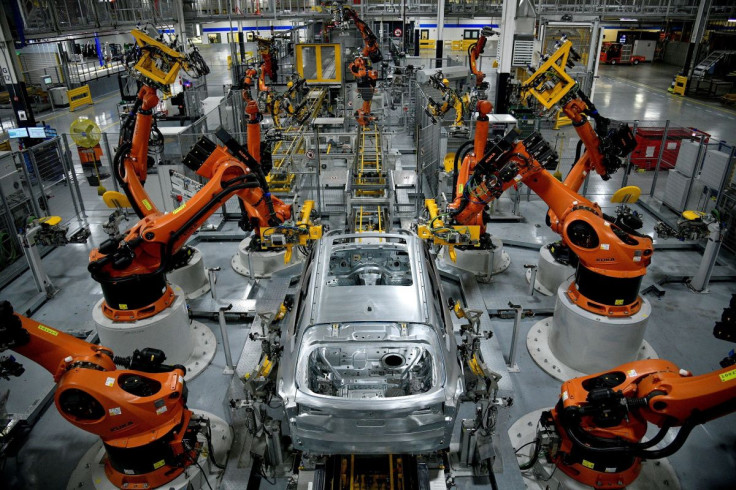U.S. Factory Activity Slows To Two-year Low As Clouds Gather Over Economy

U.S. manufacturing activity slowed more than expected in June, with a measure of new orders contracting for the first time in two years, signs that the economy was cooling amid aggressive monetary policy tightening by the Federal Reserve.
The survey from the Institute for Supply Management (ISM) on Friday also showed a gauge of factory employment contracting for a second straight month, though an "overwhelming majority" of companies indicated they were hiring.
The slowdown in manufacturing followed moderate consumer spending growth in May along with weak housing starts, building permits and factory production, which left some economists anticipating that the economy contracted again in the second quarter following a slump in gross domestic product in the first three months of the year. Another decline in GDP would not necessarily indicate a recession unless the economy suffers deep job losses.
"This does not suggest that a recession is on the way yet, but growth conditions continue to decelerate broadly in response to Fed tightening and extended cost pressures for consumers and businesses," said Ben Ayers, a senior economist at Nationwide in Columbus, Ohio.
The ISM survey's index of national factory activity dropped to 53.0 last month, the lowest reading since June 2020, when the sector was rebounding from a COVID-19 slump. That followed a reading of 56.1 in May. The index would need to decline to 43.1 to signal a recession.
A reading above 50 indicates expansion in manufacturing, which accounts for 11.8% of the U.S. economy. Economists polled by Reuters had forecast the index would fall to 54.9.
U.S. manufacturing is on better footing than factories in the euro zone and Asia. Some of the moderation in activity reflects a shift in spending back to services from goods.
All of the six largest manufacturing industries - computer and electronic products, machinery, transportation equipment, petroleum and coal products, food, and chemical products -- registered moderate-to-strong growth.
"There is a risk that we talk ourselves into a recession," said Ryan Sweet, a senior economist at Moody's Analytics in West Chester, Pennsylvania.
Recession fears were amplified by a separate report from the Commerce Department on Friday showing construction spending unexpectedly fell in May. While the Atlanta Fed has downgraded its second-quarter GDP outlook to show a contraction, Goldman Sachs sees the economy growing at a 1.9% annualized rate. GDP fell at a 1.6% rate in the first quarter.
The Fed last month raised its policy rate by three-quarters of a percentage point, its biggest hike since 1994, to quell high inflation. Another similar-sized rate hike is expected in July. The U.S. central bank has increased its benchmark overnight interest rate by 150 basis points since March.
Stocks on Wall Street were trading lower on Friday. The dollar gained versus a basket of currencies while U.S. Treasury prices rose.
SOFTENING ORDERS
The ISM survey's forward-looking new orders sub-index dropped to 49.2 from a reading of 55.1 in May. Some economists said the decline, the first below the 50 level since May 2020, reflected companies' adjusting their orders to current demand conditions after over-ordering because of strained supply chains.
"The lengthening in capex commitments suggests that business conditions remain strong," said Conrad DeQuadros, senior economic adviser at Brean Capital in New York.
Slow orders growth was a recurrent theme among most businesses, with only a few, including transportation equipment manufacturers and electrical equipment, appliances and components makers, saying demand remained strong, the ISM survey showed. But backlog orders continued to accumulate at a steady pace, which should keep factories humming.
The ISM survey still viewed stocks at clients as "too low." Business inventories were revised sharply higher in the first quarter, and major retailers like Walmart and Target have reported they are carrying too much merchandise.
Apparel, leather and allied products manufacturers said they "expect orders to decline in the coming months until inventories are leveled properly against demand."
There was some encouraging news in the survey. Its measure of supplier deliveries tumbled to 57.3 from 65.7 in May. A reading above 50 indicates slower deliveries to factories.
A gauge of prices paid by manufacturers dropped to a reading of 78.5 from 82.2 in May, supporting views that diminishing demand for goods could help to cool inflation, though that could be offset by higher prices for services.
But the survey's measure of factory employment declined further to a reading of 47.3 from 49.6 in May, likely because of a combination of waning demand and worker shortages. Technology companies like Tesla have been laying off workers.
With 11.4 million unfilled jobs across the economy at the end of April, economists cautioned against reading the continued weakness in factory employment as a sign that overall payrolls growth was faltering. First-time applications for unemployment benefits remain very low and factory payrolls rose in May.
"June's reading needs to be taken with a grain of salt," said Will Compernolle, a senior economist at FHN Financial in New York.
© Copyright Thomson Reuters 2024. All rights reserved.


















